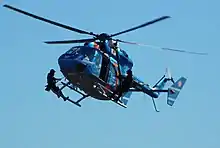Rapid reaction force
A rapid reaction force (RRF) is a military or police unit capable of responding to emergencies in a very short time frame. When used in reference to law enforcement and security forces, such as police tactical units, the time frame is usually minutes, while in military applications, such as paratroopers or commandos, the time frame can be hours to days.

Rapid reaction forces are designed to intervene quickly as a spearhead to gain and hold ground in quickly unfolding combat or low-intensity conflicts, such as uprisings that necessitate the evacuation of foreign embassies. They are usually transported by air. Rapid reaction forces are usually lightly armed—limited to small arms and light crew-served weapons, and lacking vehicles, armor, and heavy equipment—but are often very well-trained to compensate.
Examples
- The Allied Rapid Reaction Corps (ARRC) is a NATO rapid reaction force, established in 1992. A successor to the British Army's I Corps, the ARRC is capable of rapidly deploying a NATO headquarters for operations and crisis response.[1]
- The European Gendarmerie Force (EUROGENDFOR) is a European rapid reaction force under the European Union, established in 2006. An alliance of gendarmerie forces from Italy, France, the Netherlands, Poland, Portugal, Romania, and Spain, it serves as a unified intervention force of European militarized police.[2]
- The European Rapid Operational Force (EUROFOR) was a European rapid reaction force under the European Union and Western European Union, established in 1995 and composed of military units from Italy, France, Portugal, and Spain. EUROFOR was tasked with performing duties outlined in the Petersberg Tasks. EUROFOR deployed to Kosovo from 2000 to 2001, and North Macedonia as part of EUFOR Concordia in 2003. After being converted into an EU Battlegroup, EUROFOR was dissolved in 2012.
- The European Rapid Reaction Force (ERRF) was the intended result of the Helsinki Headline Goal. Though many media reports suggested the ERRF would be a European Union army, the Helsinki Headline Goal was little more than headquarters arrangements and a list of theoretically available national forces for a rapid reaction force.
- The Immediate Response Force (IRF) is an American rapid reaction force composed of units from the United States Army and United States Air Force. They are capable of responding to any location in the world within 18 hours of notice.
- The Joint Rapid Reaction Force (JRRF) was a British Armed Forces capability concept created in 1999. The force was composed of units from all three branches of the British military, and was able to rapidly deploy anywhere in the world at short notice. However, the War in Afghanistan and 2003 invasion of Iraq siphoned British personnel and equipment, leaving the JRRF with insufficient forces. The JRRF was succeeded by the Combined Joint Expeditionary Force in 2010 and the UK Joint Expeditionary Force in 2014.
- The NATO Response Force (NRF) is a NATO rapid reaction force, established in 2003. Distinct from the ARRC, the NRF comprises land, sea, air, and special forces units that can be deployed quickly.
- The Rapid Deployment Joint Task Force (RDJTF) was a former United States Department of Defense joint task force. It was formed in 1979 as the Rapid Deployment Force (RDF), envisioned as a mobile force that could quickly deploy U.S. forces to any location outside the usual American deployment areas of Western Europe and East Asia, soon coming to focus on the Middle East. It was inactivated in 1983 and reorganized as the United States Central Command.
- Riot Police Units (RPU) are the rapid reaction forces of Japanese prefectural police. They combine riot police, police tactical units, and disaster response squads under one unit. Each prefectural police force operates RPUs, sometimes under different names.
- The concept of a United Nations rapid reaction force was proposed in the mid-1990s by several commentators and officials, including Secretary-General Boutros Boutros-Ghali. The UN rapid reaction force would consist of personnel stationed in their home countries, but they would have the same training, equipment, and procedures, and would conduct joint exercises. The force would remain at high readiness at all times so as to quickly deploy them where necessary.[3]
References
- "NATO ARRC | About us". arrc.nato.int. Retrieved 2023-04-26.
- "European Gendarmerie Force - International agreement". www.geo-ref.net. Retrieved 2023-04-26.
- M., Serafino, Nina (1995). A U.N. Rapid Reaction Force? A Discussion of the Issues and Considerations for U.S. Policymakers. Congressional Research Service, Library of Congress. OCLC 50077294.